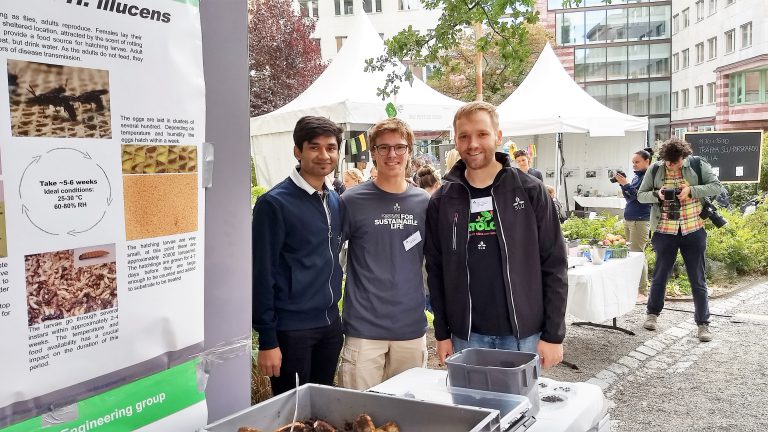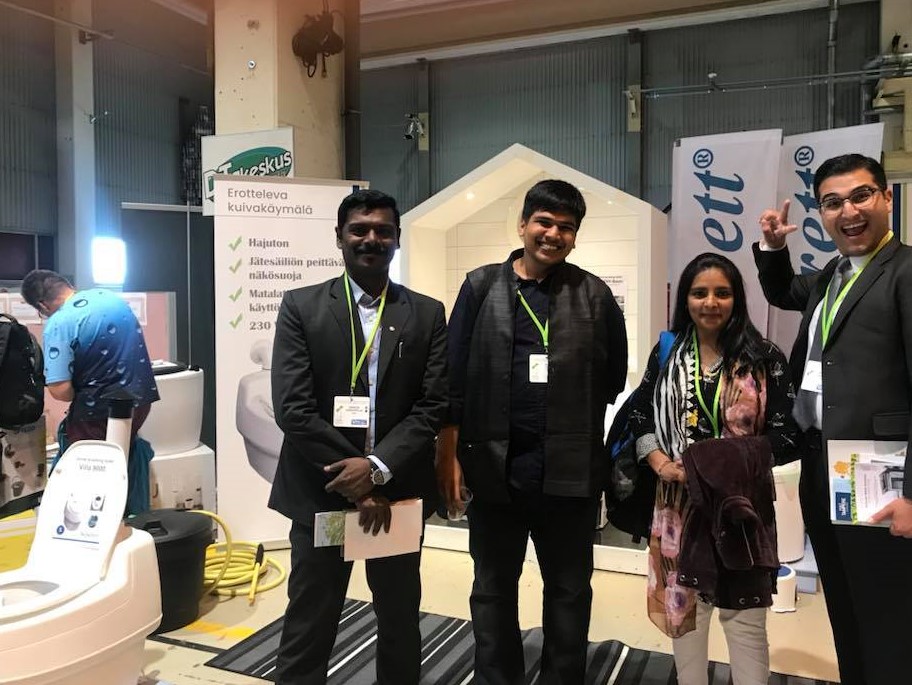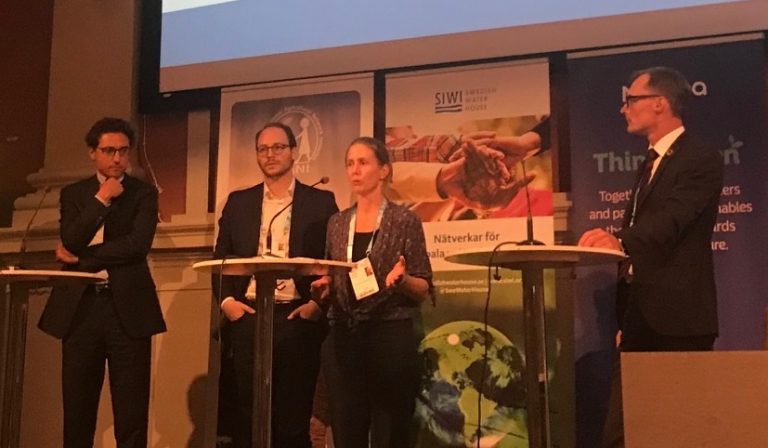Last week, Viktoria Wiklicky from our research group participated in the Summer School “Insects as Food and Feed – from producing to consuming” organised by Wageningen University. The summer school looked at various aspects of the insect food and feed chain, from from genetics to farming, handling/logistics, processing, marketing and consumption. The course was very well received by its participants, many of whom almost bombarded the lecturers with a range of interesting questions! One highlight was the study visit to Belgium where participants spent a whole day at the Thomas More University of Applied Sciences and the University of Leuven, receiving lectures and a tour through the research facilities, with focus on their ongoing insect projects. 
Category: English
Fly larvae composting presented at Matologi
 Our fly larvae team participated in the yearly Matologi event organized by SLU. This year’s exhibition had a focus on waste and climate. Evgheni Ermolaev, Giulio Zorzetto and Panav Gupta presented the Kretsloppsfluga concept being developed by the group and showed the treatment module currently being tested at a pilot plant at Eskilstuna Strängnäs Energi och Miljö AB.
Our fly larvae team participated in the yearly Matologi event organized by SLU. This year’s exhibition had a focus on waste and climate. Evgheni Ermolaev, Giulio Zorzetto and Panav Gupta presented the Kretsloppsfluga concept being developed by the group and showed the treatment module currently being tested at a pilot plant at Eskilstuna Strängnäs Energi och Miljö AB.
The 6th Dry Toilet Conference, Finland
Prithvi Simha, PhD student at kretsloppsteknik, participated in the 6th International Dry Toilet Conference that was held in Tampere, Finland, between 22-24 August. Prithvi presented our ongoing research on alkaline urine dehydration technology and shared experiences of installing & operating a household-scale urine dehydration unit for three months at the SLU campus. 
Antimicrobial resistance (AMR) seminar at the World Water Week

SLU co-organised an antimicrobial resistance (AMR) seminar at the World Water Week together with SIWI, SIANI and Nordea. Annika Nordin was our representative talking about the importance of WASH to limit the spread of AMR. The sub-workshop regarding WASH and AMR was popular, with 20 people attending. The general conclusion was that source separating sanitation may be a way to better control the spread as we contain most of the antibiotics and the pathogens in a concentrated fraction that could be managed in a simpler way compared to if it is diluted with water. Managing the AMR may require that more treatment aspects than pathogen control is considered. However, inactivating the pathogens may result in considerably improved situation compared to current situation.
New intern working on fly larvae composting
Meet Panav Gupta – the group’s latest intern from India who is currently working with the black solider fly team. During his bachelors program in civil engineering, Panav was very interested in the field of waste management, especially the potential and economic outlook of using Black Soldier Fly Larvae (BSFL) for treating various types of waste. He is visiting our group at SLU for a two month long internship that began this July. During this time, he will learn about rearing and using BSFL for treating mussels and pig feed as well as understand the prospects of using BSFL for treating lignocellulosic biomass like rice straw – a possible solution for the problem of stubble burning in North India. PC: Giulio Zorzetto
PC: Giulio Zorzetto
Crispy fried black soldier fly larvae!
After rearing about 10.000 larvae on food-graded feed (toast bread) it was time for the big harvest at our greenhouse! After purging and freezing the larvae, we seasoned portions of them with either garlic, lime juice, onions, mint, vinegar, chilli, salt or olive oil and let them soak over night. The result was absolutely amazing – fried for about 5 mins at medium heat, the larvae turned very crispy and added a perfect note to the rest of the meal. They were also enjoyed as snack, just like a bag of chips. Coming in different flavors, you could almost not stop munching on them! 



New Publication: Hygiene aspects of urine drying technology
In a new paper published in Water Research, Senecal et al. assessed what hygienic health risks may occur when human urine is dehydrated. The experiment was set up to simulate that the last person using the toilet (before the dehydration medium is changed) is contaminating the medium with misplaced faeces, with no time for dehydration of the urine, i.e. a worst-case scenario. It was found that urine dehydration in itself achieved a concentration < 1 A. suum per 4 g of dehydrated medium which fulfils the WHO guidelines for unrestricted use.
Research exhibition at University of Dar es salaam
Alice Isibika, PhD candidate at Kretsloppsteknik, participated in University of Dar es salaam’s Research Week Exhibition. The event showcased research, innovation, public service and knowledge exchange activities of the university’s academic staff and students to the public. In the post-graduate student projects category, Alice was placed third winner at the first phase and the second winner at the second phase. PC: Ramadhani Kinyogoli
PC: Ramadhani Kinyogoli
New publication: Will Indian consumers eat urine-fertilised food?
Decentralised sanitation technologies based on source separation of toilet waste have attracted a lot of research attention – the social sustainability of these technologies, not so much. To attempt to fill this gap, members of the Kretsloppsteknik group collaborated with researchers at VIT University, to explore what food consumers in India think of urine recycling. The results were recently published in the journal Water Research, where a survey of 1252 consumers at the VIT University campus revealed: 68% stated human urine should not be disposed but recycled, 55% considered it as fertiliser, but only 44% would consume food grown using it. 
The Market for Biochar in Sweden
Stockholm Exergi and Waste Sweden has conducted a study to investigate the market for biochar and specifically the willingness to pay within five industrial applications: biochar as soil improvers, biochar filling material in concrete, biochar in agriculture, biochar as filter material for water and wastewater, and biochar as additive to animal feed.
Sahar Dalahmeh (Environmental technology group – Institute for Energy and Technology) and Mikael Pell (Department of Molecular Sciences) participated in the study and contributed with their knowledge regarding the market for biochar as a filter material for water and sewage treatment. Click here to access the press release and summary where the report can also be downloaded from: https://www.avfallsverige.se/kunskapsbanken/rapporter/rapportera/?tx_news_pi1%5Bnews%5D=2583&tx_news_pi1%5Bcontroller%5D=News&tx_news_pi1%5Baction%5D=detail&cHash=68ee39223998ccc35409d625c9eaf41a
